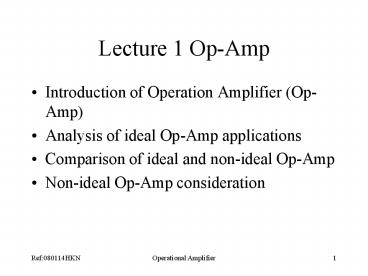Lecture 1 Op-Amp - PowerPoint PPT Presentation
1 / 27
Title:
Lecture 1 Op-Amp
Description:
Gc : Common mode gain. Common-mode rejection ratio: Note: When Gd Gc or CMRR ... a unit gain frequency f1 = 10 MHz and voltage differential gain Gd = 20V/mV ... – PowerPoint PPT presentation
Number of Views:790
Avg rating:3.0/5.0
Title: Lecture 1 Op-Amp
1
Lecture 1 Op-Amp
- Introduction of Operation Amplifier (Op-Amp)
- Analysis of ideal Op-Amp applications
- Comparison of ideal and non-ideal Op-Amp
- Non-ideal Op-Amp consideration
2
Operational Amplifier (Op-Amp)
- Very high differential gain
- High input impedance
- Low output impedance
- Provide voltage changes (amplitude and polarity)
- Used in oscillator, filter and instrumentation
- Accumulate a very high gain by multiple stages
3
IC Product
DIP-741
Dual op-amp 1458 device
4
Single-Ended Input
- terminal Source
- terminal Ground
- 0o phase change
- terminal Ground
- terminal Source
- 180o phase change
5
Double-Ended Input
- Differential input
- 0o phase shift change
- between Vo and Vd
Qu What Vo should be if,
Ans (A or B) ?
(A)
(B)
6
Distortion
The output voltage never excess the DC voltage
supply of the Op-Amp
7
Common-Mode Operation
- Same voltage source is applied
- at both terminals
- Ideally, two input are equally
- amplified
- Output voltage is ideally zero
- due to differential voltage is
- zero
- Practically, a small output
- signal can still be measured
Note for differential circuits Opposite inputs
highly amplified Common inputs slightly
amplified ? Common-Mode Rejection
8
Common-Mode Rejection Ratio (CMRR)
Differential voltage input
Common voltage input
Common-mode rejection ratio
Output voltage
Note When Gd gtgt Gc or CMRR ?? ?Vo GdVd
Gd Differential gain Gc Common mode gain
9
CMRR Example
What is the CMRR?
Solution
(2)
(1)
NB This method is Not work! Why?
10
Op-Amp Properties
- Infinite Open Loop gain
- The gain without feedback
- Equal to differential gain
- Zero common-mode gain
- Pratically, Gd 20,000 to 200,000
- (2) Infinite Input impedance
- Input current ii 0A
- T-? in high-grade op-amp
- m-A input current in low-grade op-amp
- (3) Zero Output Impedance
- act as perfect internal voltage source
- No internal resistance
- Output impedance in series with load
- Reducing output voltage to the load
- Practically, Rout 20-100 ?
11
Frequency-Gain Relation
- Ideally, signals are amplified from DC to the
highest AC frequency - Practically, bandwidth is limited
- 741 family op-amp have an limit bandwidth of few
KHz.
20log(0.707)3dB
- Unity Gain frequency f1 the gain at unity
- Cutoff frequency fc the gain drop by 3dB from dc
gain Gd
GB Product f1 Gd fc
12
GB Product
Example Determine the cutoff frequency of an
op-amp having a unit gain frequency f1 10 MHz
and voltage differential gain Gd 20V/mV
Sol Since f1 10 MHz By using GB production
equation f1 Gd fc fc f1 / Gd 10 MHz / 20
V/mV 10 ? 106 / 20 ? 103 500 Hz
13
Ideal Vs Practical Op-Amp
14
Ideal Op-Amp Applications
- Analysis Method
- Two ideal Op-Amp Properties
- The voltage between V and V? is zero V V?
- The current into both V and V? termainals is
zero - For ideal Op-Amp circuit
- Write the kirchhoff node equation at the
noninverting terminal V - Write the kirchhoff node eqaution at the
inverting terminal V? - Set V V? and solve for the desired
closed-loop gain
15
Noninverting Amplifier
- Kirchhoff node equation at V yields,
- Kirchhoff node equation at V? yields,
- Setting V V yields
- or
16
Noninverting amplifier
Noninverting input with voltage divider
Less than unity gain
Voltage follower
17
Inverting Amplifier
- Kirchhoff node equation at V yields,
- Kirchhoff node equation at V? yields,
- Setting V V yields
Notice The closed-loop gain Vo/Vin is dependent
upon the ratio of two resistors, and is
independent of the open-loop gain. This is caused
by the use of feedback output voltage to subtract
from the input voltage.
18
Multiple Inputs
- Kirchhoff node equation at V yields,
- Kirchhoff node equation at V? yields,
- Setting V V yields
19
Inverting Integrator
- Now replace resistors Ra and Rf by complex
components Za and Zf, respectively, therefore - Supposing
- The feedback component is a capacitor C, i.e.,
- The input component is a resistor R, Za R
- Therefore, the closed-loop gain (Vo/Vin) become
- where
- What happens if Za 1/j?C whereas, Zf R?
- Inverting differentiator
20
Op-Amp Integrator
- Example
- Determine the rate of change
- of the output voltage.
- Draw the output waveform.
Solution
(a) Rate of change of the output voltage
(b) In 100 ?s, the voltage decrease
21
Op-Amp Differentiator
22
Non-ideal case (Inverting Amplifier)
?
Equivalent Circuit
- 3 categories are considering
- Close-Loop Voltage Gain
- Input impedance
- Output impedance
23
Close-Loop Gain
Applied KCL at V terminal,
By using the open loop gain,
?
?
The Close-Loop Gain, Av
24
Close-Loop Gain
When the open loop gain is very large, the above
equation become,
Note The close-loop gain now reduce to the same
form as an ideal case
25
Input Impedance
26
Input Impedance
Finally, we find the input impedance as,
?
Since,
, Rin become,
Again with
Note The op-amp can provide an impedance
isolated from input to output
27
Output Impedance
Only source-free output impedance would be
considered, i.e. Vi is assumed to be 0
Firstly, with figure (a),
By using KCL, io i1 i2
By substitute the equation from Fig. (a),
?R? and A comparably large,































